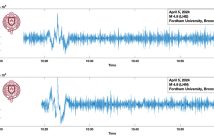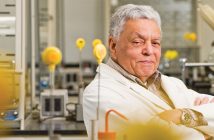
Frank Hsu, Ph.D., left, and David Dayya, D.O., M.P.H., center, of the Department of Family Medicine at St. Barnabas Hospital, discuss their study group’s autism research at a monthly meeting.
Photo by Ryan Brenizer
Nearly three years ago, a doctor from St. Barnabas Hospital came to the Department of Computer and Information Science at Fordham for help with a medical research question.
David Dayya, D.O., M.P.H., was curious about data mining, a set of techniques for plucking valuable information from the torrent of data routinely generated by computers everywhere. He had found no reports of anyone applying these tools to the causes of disease and disability.
Dr. Dayya joined forces with Frank Hsu, Ph.D., Clavius Distinguished Professor of Science, in launching an interdisciplinary study group that today is producing fresh insight into a provocative public health issue: the potential links between lead and mercury pollution and autism.
It was a natural focus because of the nationwide spike in reported autism cases, and also because of the large data sets created by the federal government and other entities to study industrial pollution throughout the country, Dr. Dayya said. Making sense of that data, however, required tools that go beyond traditional methods of data-crunching to produce connections and comparisons that bring a new level of understanding.
“There is a big difference between data and information, and knowledge and wisdom,” said Hsu, an expert in the burgeoning fields of informatics and bioinformatics.

From left: Frank Hsu, Ph.D., is an expert in informatics and bioinformatics. David Dayya, D.O., M.P.H., is a founder of the interdisciplinary study group. Christina Schweikert, Ph.D., a visiting assistant professor in the Department of Computer and Information Science, presented the group’s study in June at a conference in Taichung, Taiwan.
Photos by Ryan Brenizer
The group members, concerned about the nationwide shortage of physician-scientists, are also trying to cultivate more opportunities for medical residents to learn about informatics and statistics, and build the basic skills required for careers in research. Informatics has been applied to all sorts of tricky topics—including drug design and consumer behavior—that include diverse variables and messy data sets that can be hard to link.
For the study group’s project, the initial choice of variables was straightforward—lead and mercury are abundant in the environment, they can affect the nervous system, and autism is a nervous system disorder, in which communication and social skills are impaired.
It’s anything but simple, however, to conduct a broad study of the relationship between autism cases and mercury and lead pollution around the nation. In many states, lead and mercury are measured locally, while autism cases are only counted statewide and are often underreported, Dr. Dayya said. Some states have many pollution monitoring sites while others have few, or none.
Also, lead and mercury are diffuse in the environment. In one database, mercury and lead are measured in air particles; another shows mercury concentrations in rainwater and soil.
In light of the imperfections in the data, the study group is proceeding cautiously. “We’re progressing in a more exploratory type of analysis,” Dr. Dayya said.
The group also includes David Yens, Ph.D., an associate professor at the New York College of Osteopathic Medicine, part of the New York Institute of Technology, in Old Westbury, N.Y.; Yanjun Li, Ph.D., an assistant professor in Fordham’s Department of Computer and Information Science; and Christina Schweikert, Ph.D., a visiting assistant professor in the department.
Meeting monthly at the Rose Hill campus, they produced research that Schweikert presented in June at the Ninth IEEE International Conference on Bioinformatics and Bioengineering, held in Taichung, Taiwan. The study was published in June in the proceedings of the conference.
The team used a data mining method in which variables are given ranks and scores to convert them into a common format, making them easier to compare.
They examined data collected in numerous states between 2000 and 2006, and found an association between autism prevalence and the combination of lead and mercury. They also looked for links between pollution readings and prevalence of autism in subsequent years, and found only one: mercury levels in water were associated with autism prevalence approximately four years later, Dr. Dayya said.
This finding could suggest that exposures to mercury during pregnancy are being reflected in later diagnoses of autism, especially since the condition is typically diagnosed around age 3. But the group needs to study this relationship further using data from more U.S. states to see if it holds up, he said.
The results comport with other research that shows environmental pollution could be related to autism. But the group’s study also acknowledges that the topic goes much deeper—for instance, it notes that some people’s genetic makeup may make them more likely to develop autism after being exposed to environmental toxins.
For now, the group will pursue new data to add to its mix and keep trying novel approaches to understand it better.
“The goal is to use multiple techniques to apply to autism, lead and mercury data to get different perspectives and learn something new about the data,” Schweikert said.
The project is one sign of a growing educational emphasis in this area.
Fordham recently established an undergraduate minor in Bioinformatics, as well as an advanced graduate certificate in Biomedical Informatics jointly administered by the Biological Sciences and Computer and Information Science departments.
A medical resident at St. Barnabas who took part in the study, Martin Torrents, used the experience to gain a certificate in biomedical informatics and research that was just launched by the New York College of Osteopathic Medicine Educational Consortium through the St. Barnabas Hospital affiliate.
Dr. Dayya invites medical residents from St. Barnabas and elsewhere to participate in the group’s sessions; he and Hsu are also seeking funds for a fellowship program to train more medical residents in statistics and informatics.
The dearth of doctors who are also trained researchers is a nationwide problem that has drawn the attention of the National Institutes of Health, Dr. Dayya said. “There’s a nationwide call for more physicians in research, more clinical scientists, and there is a grave shortage of them,” said Dr. Dayya, who has a background in biostatistics. “They’ve been described as the bridge between basic science and the patient, i.e. the facilitators of translation research.”
“We don’t have a lot of physicians trained to be able to do this kind of research that we’re talking about, and this is our humble effort to help advance that national goal,” he said. “The relationship between us has been so productive that we are anticipating regular publications in this area.”


